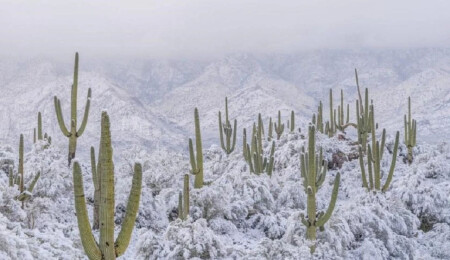It snowed in North America's hottest desert

The Sonora Desert spans an area of approximately 250,000 kilometers in the southwest of Mexico and the United States.

The brief but welcome snowfall in North America's hottest desert has been caught on camera in previous weeks.
In the Mexican states of Baja California, Sonora and Southern Lower California, and in the US states of Arizona and California, the thickness of the snow falling on a part of the Sonora Desert, which spans an area of approximately 250,000 square kilometers, was approximately 5 to 10 centimeters for 4 hours.
Pulitzer Prize-winning landscape photographer Jack Dykinga captured the snow covering the cacti on March 2.
Dykinga, who has photographed the Sonora Desert since 1976, says it hasn't had snow in the area for 10 years. The photographer adds that the landscape "was out of place, completely magical and strikingly beautiful."
One meteorologist describes it as a snowfall "once in every generation".
The precipitation may be linked in part to the final stages of the La Niña climate pattern, the cold phase of the El Niño-Southern Cycle (ENSO), which scientists say ended on March 9.
In addition to La Niña, US National Weather Service meteorologist Bianca Feldkircher told the Associated Press that the persistent pattern of obstruction over the Pacific, as well as cold air moving south from the Arctic, is paving the way for extensive snowfall along the West Coast of the US. .
The western US has seen massive amounts of snowfall this winter, The Independent reports. Snow depth in Flagstaff, in northern Arizona, reached nearly 3 meters, reaching its highest level in the last 70 years. In California, a record snowfall with a thickness of about 12 meters occurred.
While the Sonora Desert experiences extremely high temperatures (with scorching temperatures often exceeding 40 degrees Celsius in the summer and as high as 48 degrees Celsius in the summer), temperatures drop during the winter months.
The U.S. National Park Service notes that the climate remains mostly temperate in the valleys, but heavy snow cover is often seen at higher altitudes in mountainous regions.


Comments
Attention!
Sending all kinds of financial, legal, criminal, administrative responsibility content arising from illegal, threatening, disturbing, insulting and abusive, humiliating, humiliating, vulgar, obscene, immoral, damaging personal rights or similar content. It belongs to the Member / Members.